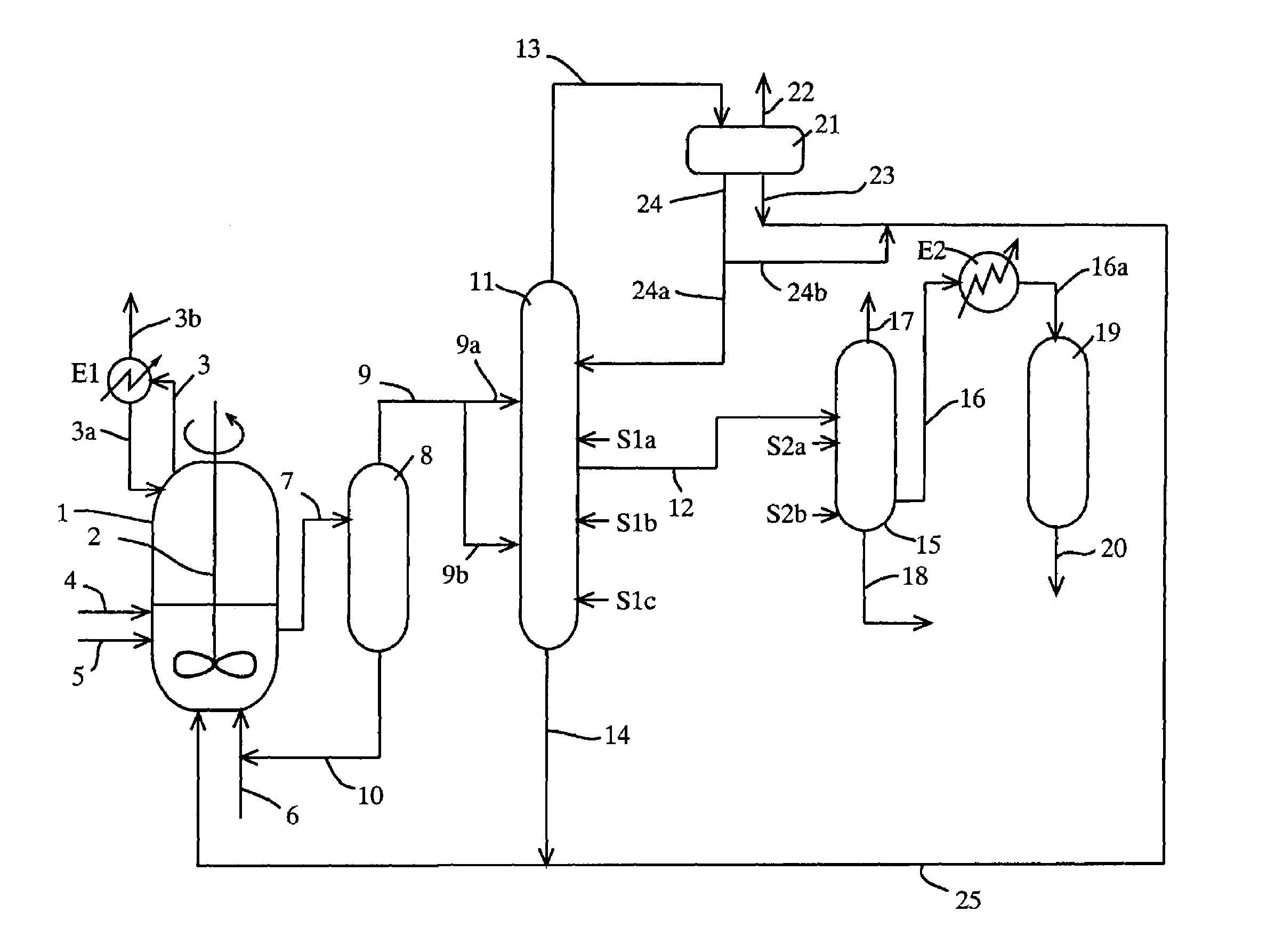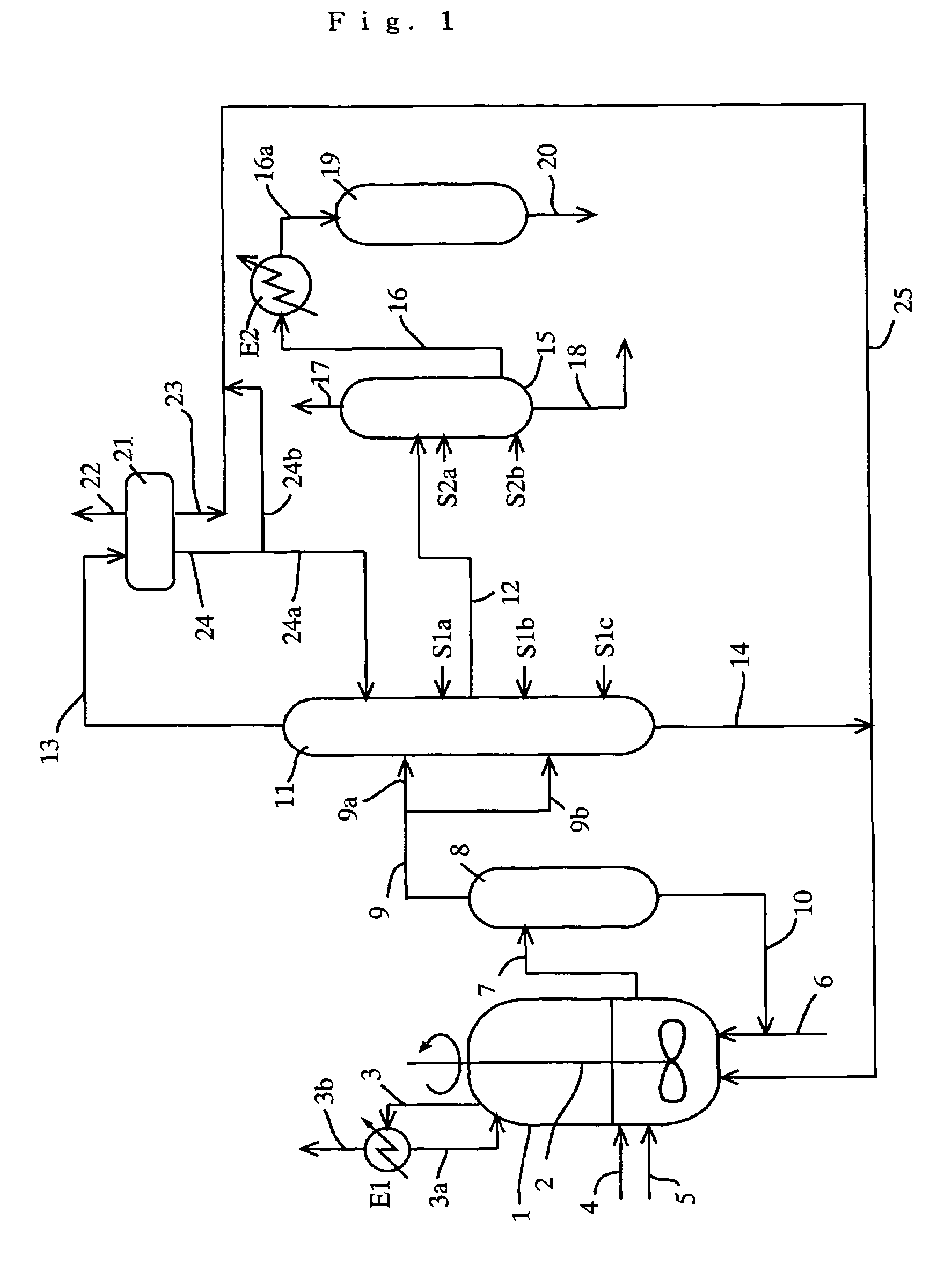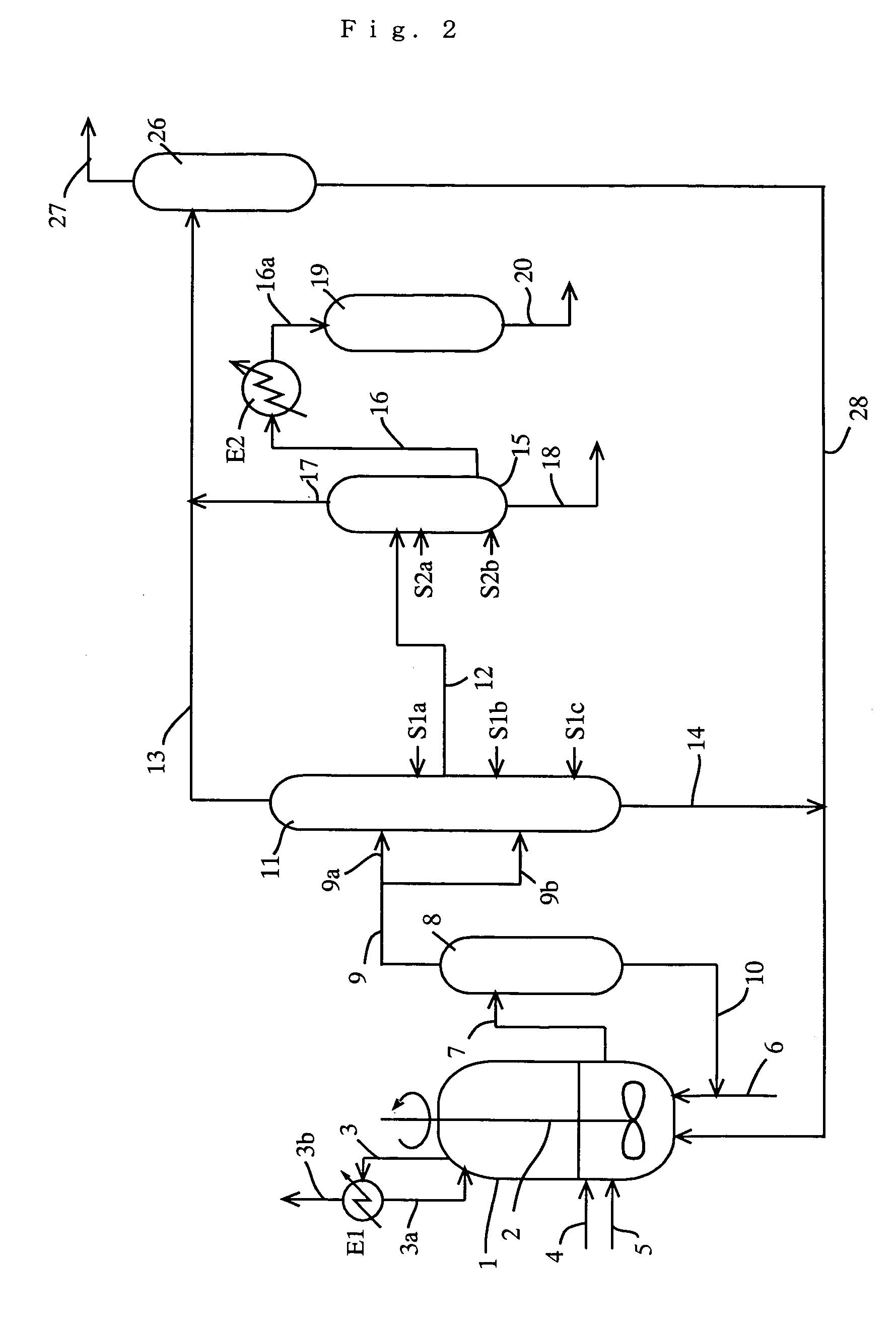Process for producing carboxylic acid
a carboxylic acid and process technology, applied in the field of carboxylic acid production process, can solve the problems of high inability to effectively eliminate hydrogen iodide, and difficulty in sufficiently reducing the concentration of hydrogen iodide in acetic acid, so as to achieve efficient separation, reduce boiling point fraction, and reduce the concentration of hydrogen halide contained in carboxylic acid as a final product
Inactive Publication Date: 2010-03-16
DAICEL CHEM IND LTD
View PDF6 Cites 67 Cited by
- Summary
- Abstract
- Description
- Claims
- Application Information
AI Technical Summary
Benefits of technology
The present invention relates to a process for reducing the concentration of hydrogen iodide in a carboxylic acid as a final product. The invention proposes a method for inhibiting the condensation of hydrogen iodide in a distillation column by adding a component such as methanol or an ion exchange resin to the distillation column. The invention also provides a system for producing a carboxylic acid with a reduced concentration of hydrogen iodide. The technical effects of the invention include reducing corrosion, preventing equipment blockage, improving product quality, and reducing costs associated with the treatment process.
Problems solved by technology
Accordingly, even when such a mixture is distilled, hydrogen iodide cannot be efficiently removed, and as a result, it is difficult to sufficiently reduce a concentration of hydrogen iodide in acetic acid as a final product.
Moreover, high concentration of hydrogen iodide accelerates corrosion of the distillation column and peripheral equipment.
However, even in these processes, hydrogen iodide cannot be effectively eliminated.
As a result, the costs for the treatment increase.
Moreover, since the product acid stream is removed at the base of the distillation zone, it is impossible to efficiently separate and recover the entrained rhodium catalyst.
In addition, the operating trouble occurs due to blockage, or the quality of product is deteriorated, as well as it is unfavorable in costs.
Therefore, it is difficult to conduct these processes industrially.
However, the concentration of hydrogen iodide contained in product acetic acid cannot be sufficiently reduced.
However, in such a process, because of fluctuation of the peak position of hydrogen halide concentration due to variable factors (such as temperature, and pressure) in the distillation step, contamination of an acetic acid as a final product with hydrogen iodide sometimes occurs.
Further, due to affinity between hydrogen iodide and water, it is impossible to remarkably reduce the hydrogen iodide concentration in the acetic acid.
However, in such a process, since it is impossible to remove carbonyl impurities having higher boiling points (such as an aldehyde, a carboxylic acid and an ester), a result in a potassium permanganate test which is a standard of a product acetic acid is deteriorated and the quality of the product is lowered.
Further, it is difficult to remove higher boiling point components such as metal impurities and sulfate.
However, in the case where the R is hydrogen atom, it is known that the dissociation energy of the bond R—X is extremely large.
For example, the dissociation energy of hydrogen iodide (HI) is 299 kJ / mol, and it is extremely difficult to separate and remove hydrogen iodide by a guard bed in principle.
Moreover, thus obtained acetic acid is industrially and / or commercially insufficient in the light of the quality of the product and the corrosion of the equipment.
However, removal of hydrogen iodide by introducing the above reagent such as an alkali metal hydroxide into the first distillation column having a very high concentration of hydrogen iodide requires an extremely amount of the reagent.
In addition, the amount of an alkali metal iodide generated by the treatment increases.
Therefore, it is environmentally and economically disadvantageous in the light of separation or disposition.
Moreover, since a large amount of potassium acetate generated from neutralization between acetic acid and the alkali metal hydroxide comes to be mixed in the product, the yield of acetic acid is deteriorated.
However, in the overhead, the proportions of hydrogen iodide and water are large.
Method used
the structure of the environmentally friendly knitted fabric provided by the present invention; figure 2 Flow chart of the yarn wrapping machine for environmentally friendly knitted fabrics and storage devices; image 3 Is the parameter map of the yarn covering machine
View moreImage
Smart Image Click on the blue labels to locate them in the text.
Smart ImageViewing Examples
Examples
Experimental program
Comparison scheme
Effect test
examples
[0198]The following examples are intended to describe this invention in further detail and should by no means be interpreted as defining the scope of the invention.
the structure of the environmentally friendly knitted fabric provided by the present invention; figure 2 Flow chart of the yarn wrapping machine for environmentally friendly knitted fabrics and storage devices; image 3 Is the parameter map of the yarn covering machine
Login to View More PUM
| Property | Measurement | Unit |
|---|---|---|
| partial pressure | aaaaa | aaaaa |
| partial pressure | aaaaa | aaaaa |
| temperature | aaaaa | aaaaa |
Login to View More
Abstract
A process for producing a purified carboxylic acid having “n+1” carbon atoms comprises feeding a carboxylic acid stream containing a carboxylic acid having “n+1” carbon atoms, a hydrogen halide, a lower boiling point (bp) component, a higher bp component, and others to a first distillation column; separating a lower bp fraction containing part of the lower bp component and a higher bp fraction containing part of the higher bp component in the first column; withdrawing a side stream containing at least the carboxylic acid by side cut from the first column; feeding the side stream to a second distillation column; separating a lower bp fraction containing part of the lower bp component and a higher bp fraction containing part of the higher bp component in the second column; and withdrawing a side stream containing the carboxylic acid by side cut from the second column to recover a purified carboxylic acid; and the process further comprises feeding at least one first component (A) selected from the group consisting of an alcohol, corresponding to the carboxylic acid, having “n” carbon atom(s), and an ester of the alcohol with the carboxylic acid to the first column, and if necessary water. Such a process ensures reduction of the concentration of the hydrogen halide in the purified carboxylic acid.
Description
TECHNICAL FIELD[0001]The present invention relates to a process useful for reducing a concentration of a hydrogen halide contained in a carboxylic acid as a final product by inhibiting condensation of the hydrogen halide (e.g., hydrogen iodide) in a distillation column, for example, a distillation process, and a production process of a carboxylic acid (e.g., acetic acid); and a system for producing a carboxylic acid.BACKGROUND ART[0002]In a production of acetic acid, when a solution containing water, hydrogen iodide, iodide ion (hereinafter, hydrogen iodide and / or iodide ion are / is sometimes simply referred to as hydrogen iodide), methyl iodide, methyl acetate, acetic acid, and others is distilled and purified, hydrogen iodide is condensed in a distillation column thereof due to interaction between hydrogen iodide and water. Accordingly, even when such a mixture is distilled, hydrogen iodide cannot be efficiently removed, and as a result, it is difficult to sufficiently reduce a con...
Claims
the structure of the environmentally friendly knitted fabric provided by the present invention; figure 2 Flow chart of the yarn wrapping machine for environmentally friendly knitted fabrics and storage devices; image 3 Is the parameter map of the yarn covering machine
Login to View More Application Information
Patent Timeline
 Login to View More
Login to View More Patent Type & Authority Patents(United States)
IPC IPC(8): C07C51/42
CPCC07C51/44C07C53/08C07C53/122
Inventor MIURA, HIROYUKIKOJIMA, HIDETAKA
Owner DAICEL CHEM IND LTD
Features
- R&D
- Intellectual Property
- Life Sciences
- Materials
- Tech Scout
Why Patsnap Eureka
- Unparalleled Data Quality
- Higher Quality Content
- 60% Fewer Hallucinations
Social media
Patsnap Eureka Blog
Learn More Browse by: Latest US Patents, China's latest patents, Technical Efficacy Thesaurus, Application Domain, Technology Topic, Popular Technical Reports.
© 2025 PatSnap. All rights reserved.Legal|Privacy policy|Modern Slavery Act Transparency Statement|Sitemap|About US| Contact US: help@patsnap.com



